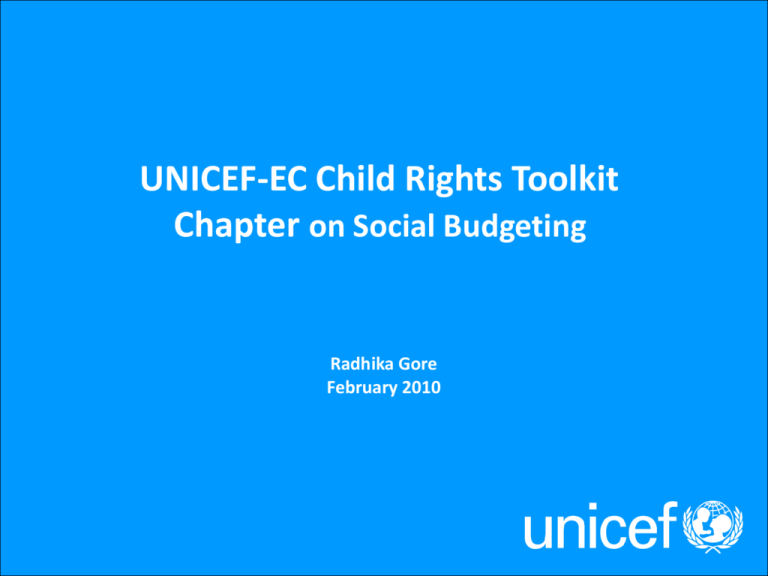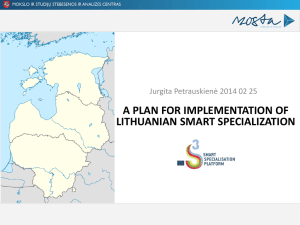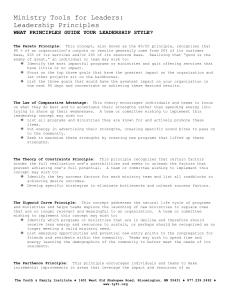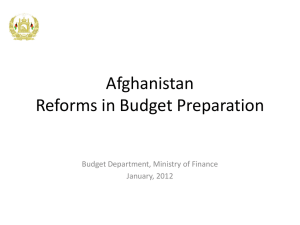Presentation
advertisement

UNICEF-EC Toolkit Background Paper on Social Budgeting UNICEF-EC Child Rights Toolkit Chapter on Social Budgeting Draft Radhika Gore Radhika Gore February 2010 February19, 2010 1 Overview of the paper What is social budgeting? Ensure that social priorities and rights are reflected in - budget allocations - budget-making , expenditure, monitoring processes Audience Non-specialists in economics/public finance, but familiar with general objectives of social budgeting Concerned with advancing children’s rights Aim To function as a reference guide 2 Approach Review literature Key issues – theory and reality of budgeting Draw upon practical experience of UNICEF & partners Highlight strategic entry points Practical challenges – politics, organizational capacity Need to document cases Illustrate with examples Takeaway – issues, ideas, tools, networks for collaboration • • Culled from many different sources Any awkward language… to be revised 3 Organization of the paper 2 Principles 3 Research and documentation: The budget cycle Theory and reality of the budget process 4 Practical programming guidance Challenges faced Supporting budget work 5 Characterizing budget initiatives: Examples Impetus, initiation, objectives of budget work Linking budgets and children’s rights 6 Monitoring guidance 7 Donors’ role 4 Principles Responsiveness to children’s rights Budget reflects priorities of Convention on the Rights of the Child Addresses considerations of girls and boys Social budgeting is applied budget work Equity Non-discrimination, social inclusion, attention to power relations Efficiency Raising revenues, allocating resources, and achieving outcomes with least distortions and costs Accountability Transparent processes, subjected to public scrutiny Stabilization Pro-poor countercyclical policies & social protection 5 Attention shift Budget as main channel to deliver services & donor aid Attention shift to “…. complex web of actors and institutions involved in the budget process …” Old Paradigm ‘Conventional Budgeting’ New Paradigm ‘Public Expenditure Management’ Budget process Rules Inputs Compliance Centralized control Bureaucratic opaqueness Budget policies and institutions Incentives Outputs/outcomes Performance Decentralized responsibility Transparency and accountability Source: ODI Briefing Paper May 2004 6 The budget cycle Drafting 3.2.1 Overview of budget formulation by the executive 3.2.2 What can happen in reality 3.2.3 Influencing the budget at the formulation stage Approval … Execution … Audit … 7 The budget cycle Drafting Finance ministry - sets economic forecast and spending caps Executive or line ministries - propose spending plans Approval Negotiation between line ministries and legislature Execution Line ministries execute budget and keep accounts Audit Expenditures subject to an independent audit 8 The budget cycle Drafting Finance ministry - sets economic forecast and spending caps Executive or line ministries - propose spending plans Closed process, lack research capacity, lack data Approval Negotiation between line ministries and legislature Execution Line ministries execute budget and keep accounts Audit Expenditures subject to an independent audit 9 Open Budget Index OBI 2008 Performance Extensive (Score 81-100) Significant (Score 61-80) Some (Score 41-60) Minimal (Score 21-40) Scant or no information (Score 0-20) Overall No. of countries Countries 5 France, New Zealand, South Africa, UK, US 12 Botswana, Brazil, Czech Republic, Germany, … , Slovenia, South Korea, Sri Lanka, Sweden 27 Costa Rica, Croatia, Egypt, … , Papua New Guinea, Philippines, Russia, Serbia, Turkey, Uganda, Ukraine, … 16 Albania, Azerbaijan, Ecuador, … , Niger, Pakistan, Tanzania, Thailand, Trinidad and Tobago, Venezuela 25 85 Afghanistan, Algeria, Angola, Bolivia, Burkina Faso, … , Saudi Arabia, Senegal, Sudan, Vietnam, Yemen Source: 2008 The Open Budget Survey, The International Budget Partnership 10 Budget drafting Is methodology used for making economic assumptions of the budget publicly available? No OECD members Number % Number % 11 37 19 31 3 5 Yes, only to parts of the legislature Yes, it is publicly available on request Yes, it is published Other 7 23 20 33 11 37 14 23 1 3 4 7 1 2 61 100 Missing answer Total Non-OECD 30 100 Source: 2007 OECD International Database of Budget Practices & Procedures 11 The budget cycle Drafting Finance ministry - sets economic forecast and spending caps Executive or line ministries - propose spending plans Closed process, lack research capacity, lack data Approval Negotiation between line ministries and legislature Execution Line ministries execute budget and keep accounts Audit Expenditures subject to an independent audit 12 The budget cycle Drafting Finance ministry - sets economic forecast and spending caps Executive or line ministries - propose spending plans Closed process, lack research capacity, lack data Approval Negotiation between line ministries and legislature Legislature constrained : Lack power to amend, capacity for analysis, timing of process Execution Line ministries execute budget and keep accounts Audit Expenditures subject to an independent audit 13 Start of budget process Budget Legislature approves budget tabled Research and Documentation Source: De Renzio and Wehner (2008) 14 Budget approval Is there a specialized budget research office attached to the legislature? OECD members Number Non-OECD % Number % No 19 63 39 64 Yes 11 37 16 26 Other 5 8 Missing 1 2 61 100 Total 30 100 Source: 2007 OECD International Database of Budget Practices & Procedures 15 The budget cycle Drafting Finance ministry - sets economic forecast and spending caps Executive or line ministries - propose spending plans Closed process, lack research capacity, lack data Approval Negotiation between line ministries and legislature Legislature constrained : Lack power to amend, capacity for analysis, timing of process Execution Line ministries execute budget and keep accounts Audit Expenditures subject to an independent audit 16 The budget cycle Drafting Finance ministry - sets economic forecast and spending caps Executive or line ministries - propose spending plans Closed process, lack research capacity, lack data Approval Negotiation between line ministries and legislature Legislature constrained : Lack power to amend, capacity for analysis, timing of process Execution Line ministries execute budget and keep accounts Misuse, weak financial management (procurement, delays), corruption , diversion, underfunded programs Audit Expenditures subject to an independent audit 17 Civil society-led monitoring efforts Malawi Civil Society Coalition for Quality Basic Education - Produces national aggregation of school budget monitoring Identifies poorly maintained public school assets Comments on timing for release of funds The Philippines Concerned Citizens of Abra for Good Government - Began with focus on road infrastructure projects Exposed discrepancies in government reports Ensure project funds are used as intended Project beneficiaries included in monitoring projects 18 The budget cycle Drafting Finance ministry - sets economic forecast and spending caps Executive or line ministries - propose spending plans Closed process, lack research capacity, lack data Approval Negotiation between line ministries and legislature Legislature constrained : Lack power to amend, capacity for analysis, timing of process Execution Line ministries execute budget and keep accounts Misuse, weak financial management (procurement, delays), corruption , diversion, underfunded programs Audit Expenditures subject to an independent audit 19 The budget cycle Drafting Finance ministry - sets economic forecast and spending caps Executive or line ministries - propose spending plans Closed process, lack research capacity, lack data Approval Negotiation between line ministries and legislature Legislature constrained : Lack power to amend, capacity for analysis, timing of process Execution Line ministries execute budget and keep accounts Misuse, weak financial management (procurement, delays), corruption , diversion, underfunded programs Audit Expenditures subject to an independent audit Audit agency not empowered to investigate, lacks staff. Delays. Legislature fails to review findings/act on violations 20 Audit Strategies for the legislature - Sub-committees can examine subject areas Seek input from independent experts Strategies for civil society - Support legislature by following up on corruption - In South Africa, the Public Sector Accountability Monitor : - obtains details about corruption cases - informs government department - follows up with department a month later - records response and makes it available online 21 Challenges faced So we know what the entry points are Seen some brief examples of what actors have done Next section deals with practical challenges Main takeaway • Not always easy Openness, data access, expertise, media interest … • But examples accumulating • Documentation? • Evaluation? Draws upon experience of UNICEF and partners 22 Challenges faced - Openness and priorities of government - Availability of expertise within/outside government - Dominance of finance ministry, IFIs - Civil society activism and media interest 23 Challenges faced Openness and priorities of government Brazil • • Egypt • CEE/CIS • India • history of open public accounts, active civil society CSOs can examine social expenditures, raise public awareness budget data considered sensitive information gender inequality not perceived as priority in budget reform inroads made by gender budget initiatives First tasks might be to • convince government of advantages of budget analysis • introduce relevance of social budgeting for children’s rights 24 Challenges faced Establishing credibility in public finance Finance ministry, IFIs have dominant position regarding: budget decisions, public finance mgmt, setting economic policy Availability of expertise Local knowledge and access, sustainability of budget work Level of civil society activism Low civil society participation and media interest/attention Potential first steps • develop government capacity for analysis • generate evidence • convene decision-makers • identify national research skills and media interest • support channels for public participation 25 Supporting budget work Strategic guidance - E.g. research design, public outreach strategies How to apply analytical tools, e.g. Public Expenditure Tracking Surveys Cross-national comparative studies Building capacity for budget analysis and advocacy - Institutional partnerships, e.g. leverage relationships with IFIs Media, parliamentarians, opinion-makers Knowledge networking, peer review, expert advice - Document knowledge about social budgeting - process and findings Collaborate to gain complementary expertise and peer review Exchange experience with other organizations 26 Characterizing budget work Diversity of approaches • Impetus or initial motivation strategic response to a crisis technical analysis or an advocacy effort convening stakeholders to build consensus and raise awareness partnership opportunities • Objectives improving PFM and budgeting procedures building capacity of government actors enhancing social inclusion and participation instituting policy or legislative reform enabling cross-national tracking of budget openness 27 Impetus Response to a crisis Mozambique. End of civil war, 1992, opportunity for PFM reform: modernize legal framework for budgeting, introduce new accounting system, etc. Technical analysis or advocacy effort Croatia. Institute of Public Finance, founded 1970, state-funded research organization. Broadened focus to publicly-oriented budget analysis. Convening stakeholders Kazakhstan. UNICEF conference in 2007, attended by Ministry of Economy and Budget and Planning, led to informal working group (parliament+govt agencies) Strategic partnerships The Philippines. Alternative Budget Initiative. CSOs provide research to draft alternative budget. Legislators push for its incorporation in budget deliberations 28 Objectives Improving PFM and budgeting procedures Sierra Leone. Analysis of how public finance system impacts children Building capacity of government actors Mexico. Legislators received training on budget analysis from national NGO Enhancing social inclusion and participation Brazil. Children’s participation for monitoring budget implementation Instituting policy or legislative reform South Africa. Costing of Child Justice Bill before it was tabled in the legislature Enabling cross-national tracking of budget openness OECD survey of budget practices and procedures in OECD & nonOECD countries 29 Linking children’s rights + budgets Budget approval - In Brazil, Save the Children Sweden along with local NGOs supported children’s participation in the approval and monitoring of the budget in the city of Fortaleza in the state of Ceara. - Kenya’s Inter-Parliamentary Union held a regional workshop in May 2000 to discuss how the budgetary process was influenced by gender perspectives. Partners included UNICEF and the Commonwealth Parliamentary Association (see Vergara, 2009). Audit and performance evaluation - In Ghana, the Northern Ghana Network for Development (NGND) involved communities in assessing the performance of community schools using a scorecard method. NGND also collected information on education expenditure in order to assess the quality of service given the costs. The analysis was used for constructive dialogue between communities and the district education directorate on issues such as school infrastructure and management (see Vergara, 2009). 30 Monitoring & Evaluation Debate on aid effectiveness has spurred interest in evidence on results • How does impact evaluation apply to budget initiatives? Identify results in terms of • Changes in budget allocations • Reform of budget policies and institutions How to measure impact? Old Paradigm Budget process Rules Inputs Compliance Centralized control Bureaucratic opaqueness New Paradigm Budget policies and institutions Incentives Outputs/outcomes Performance Decentralized responsibility Transparency and accountability 31 Example: Tracing results Uganda: Gender responsive budgeting (GRB) • • • • • Initiated in 1999 by coalition of women’s rights groups and parliamentarians Key player: Forum for Women in Democracy (FOWODE) Used research, advocacy, activism to influence fiscal policy Organized GRB skills-building workshops for legislators and technocrats Invited by Ministry of Finance to participate in budget process Some achievements • • • • • 2003: Government included gender and equity in “Budget Call Circular” 2004: MoF with Ministry of Gender, Labour & Social Development prepared guidelines to assist in preparation of sector budgets 2005: MoF organized GRB capacity building of planners and budget officers Gender policies & indicators strengthened in Poverty Eradication Action Plan To ensure implementation, gender included in PRS Credit 32 Example: Tracing results Uganda: Gender responsive budgeting (GRB) - May be several years before impact is evident as policy or funding change • Initiated in 1999 by coalition of women’s rights groups and parliamentarians •- Role Keyof player: foradvocacy Women ingroups? Democracy (FOWODE) otherForum budget • Used research, advocacy, activism to influence fiscal policy •- Documentation Organized GRB skills-building for legislators and technocrats of successesworkshops and failures? • Invited by Ministry of Finance to participate in budget process • Some achievements • • • • • 2003: Government included gender and equity in “Budget Call Circular” 2004: MoF with Ministry of Gender, Labour & Social Development prepared guidelines to assist in preparation of sector budgets 2005: MoF organized GRB capacity building of planners and budget officers Gender policies & indicators strengthened in Poverty Eradication Action Plan To ensure implementation, gender included in PRS Credit 33 Example: Tracing results Brazil: Municipal Seal of Approval Encourage municipalities to achieve targeted results in service delivery and disseminate information about these efforts What the program does • Groups municipalities according to socio-demographic characteristics • Monitors social indicators from baseline study • Gives feed-back to each municipality • Mobilizes children through campaigns and competitions • Makes rules for comparative evaluation of municipalities’ performance Easier to say what the change was, but can we say exactly why? Need more work on this … 34 Donor role New modalities of aid: budget support as opposed to project aid Implications • • • • • If children’s rights viewed as ‘crosscutting’ issue and not already well established in aid programmes, then attention to children’s issues may suffer Donors could enhance impact of aid if they systematically strengthened country’s systems and practices used for all government expenditures Align aid interventions with countries’ public finance mgmt system Decrease use of project implementation units Provide more and better information on their own aid flows On average, only 45 percent of aid uses country PFM systems • from 0 percent in Democratic Republic of Congo • to 77 percent in Bangladesh 35 Thank you 36





